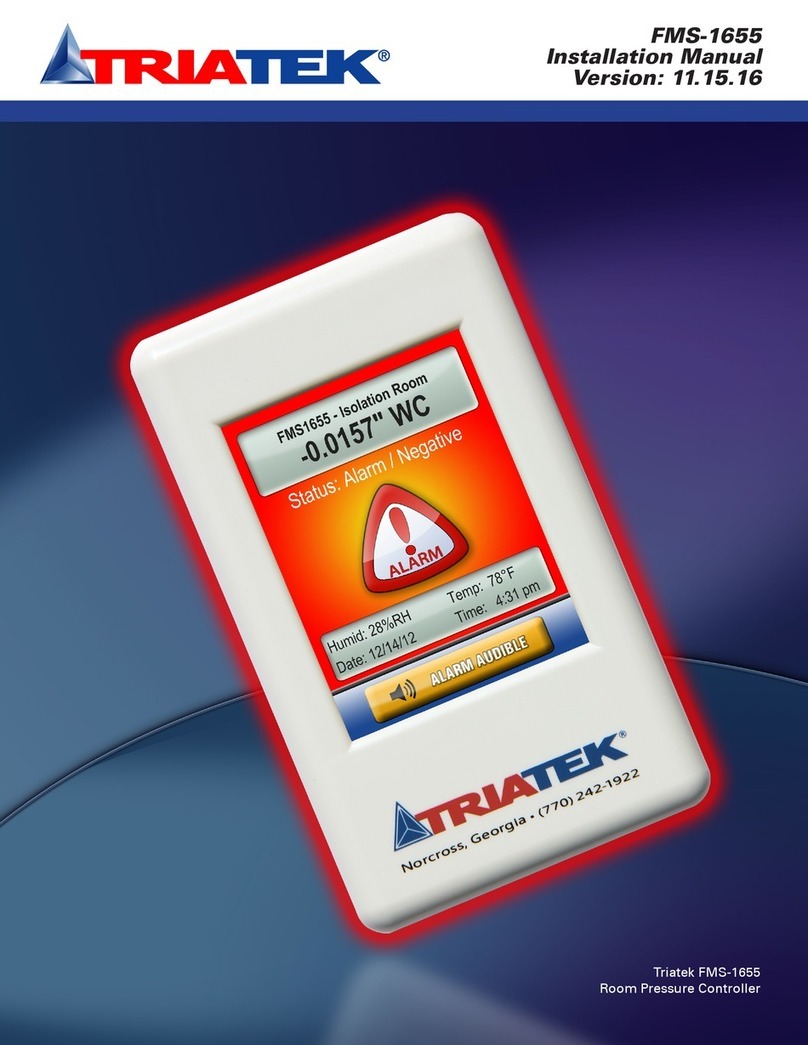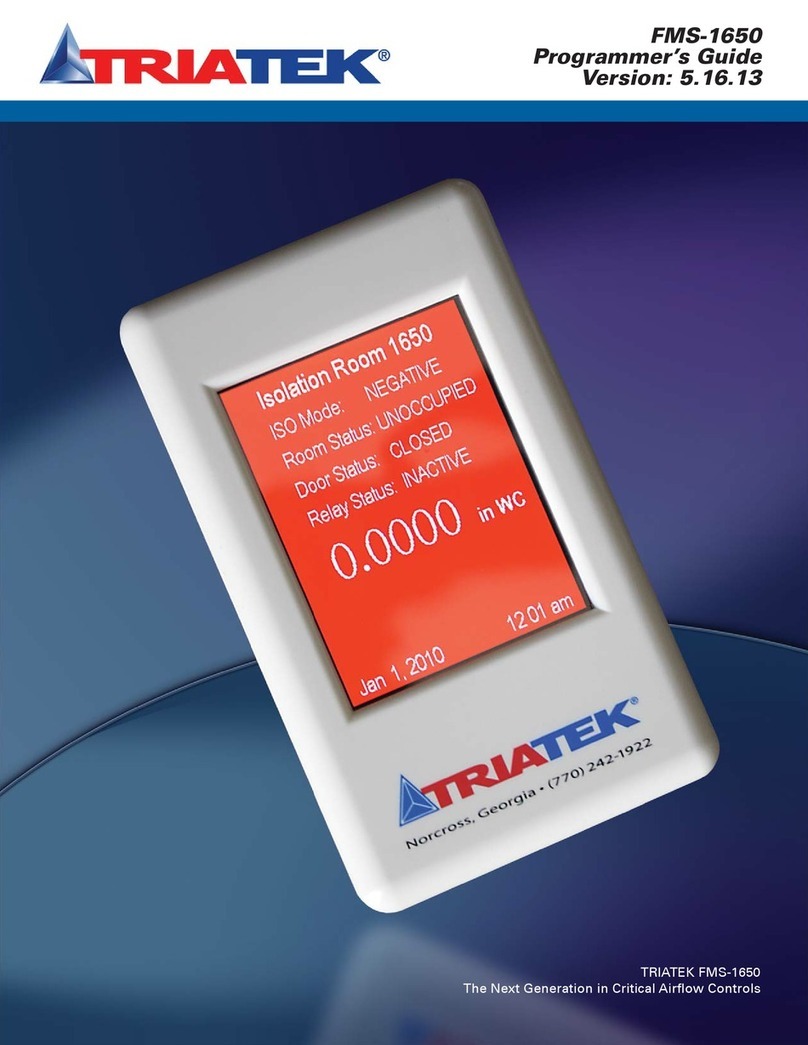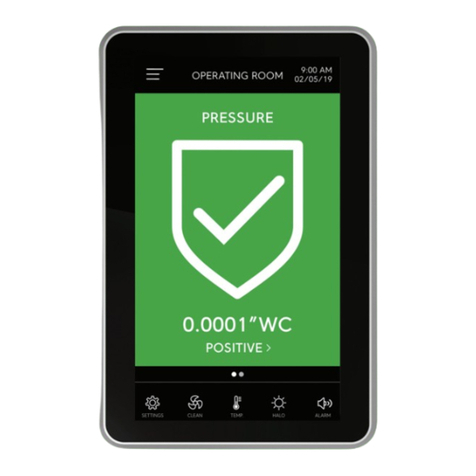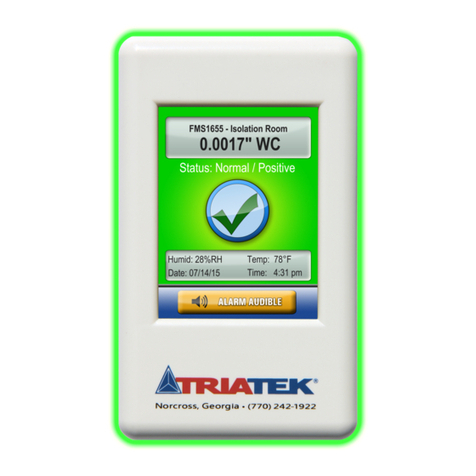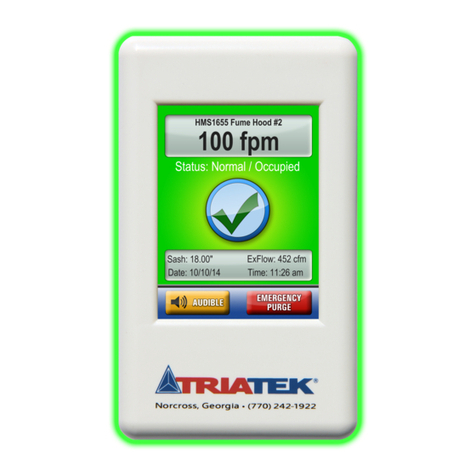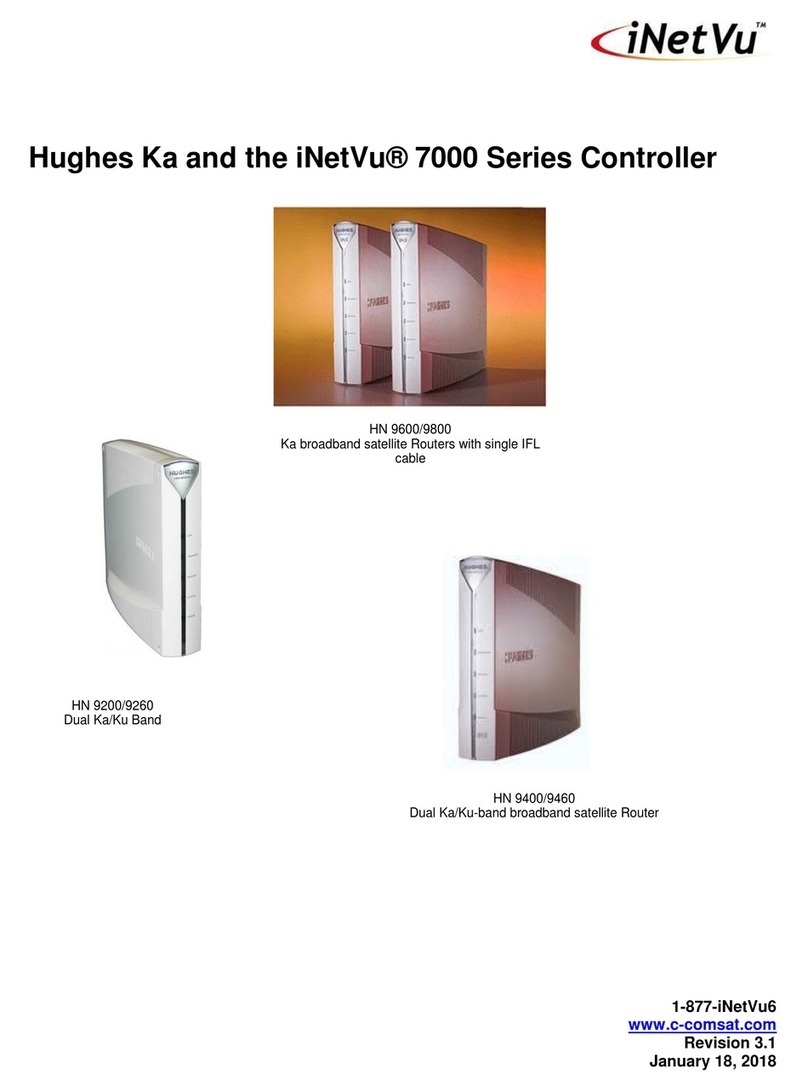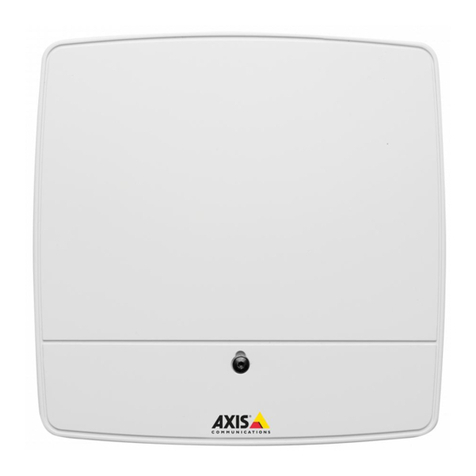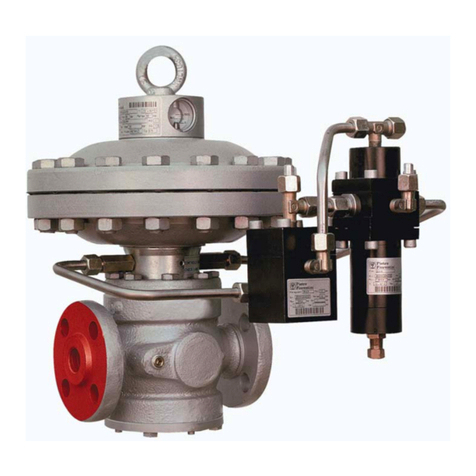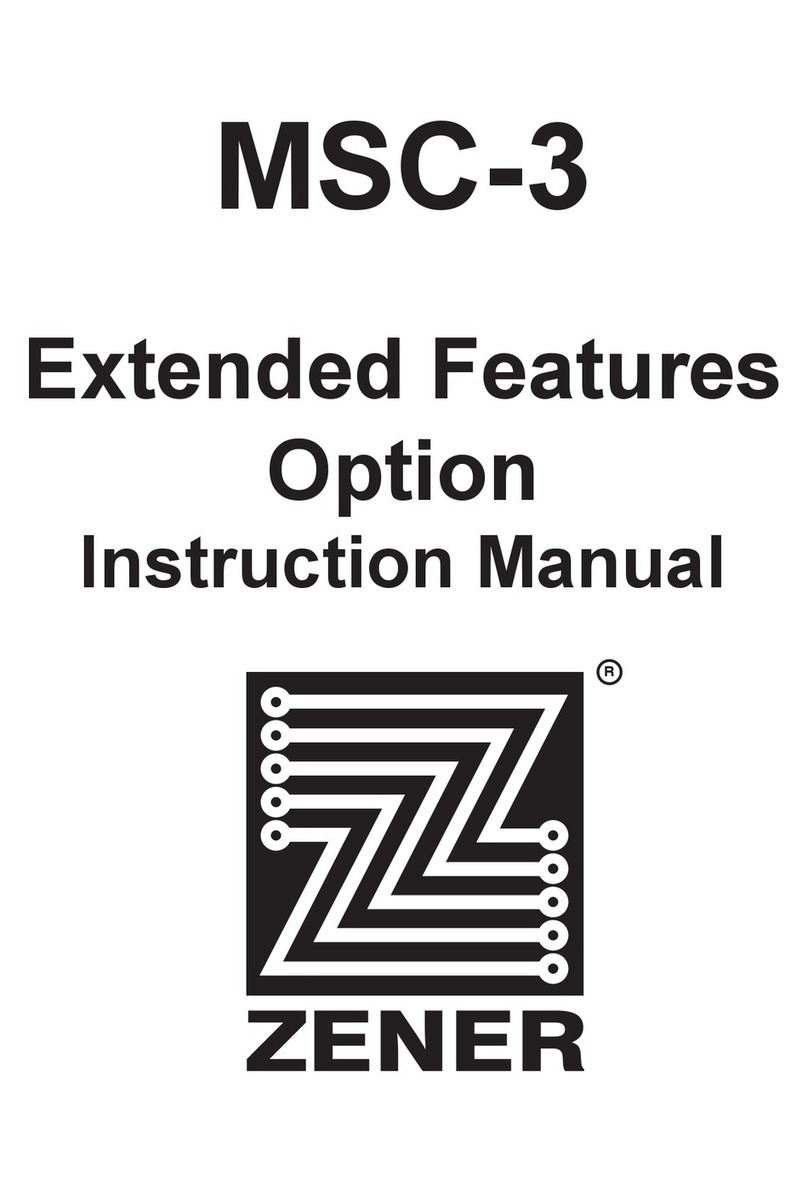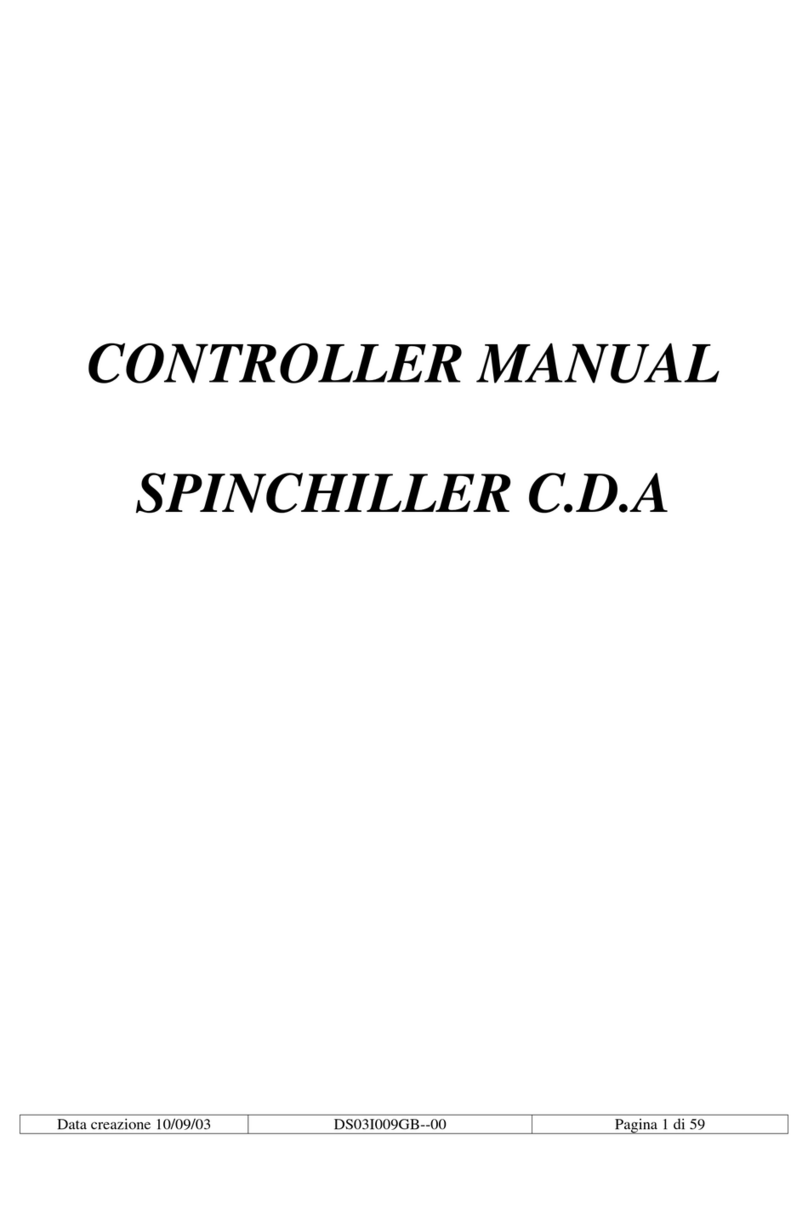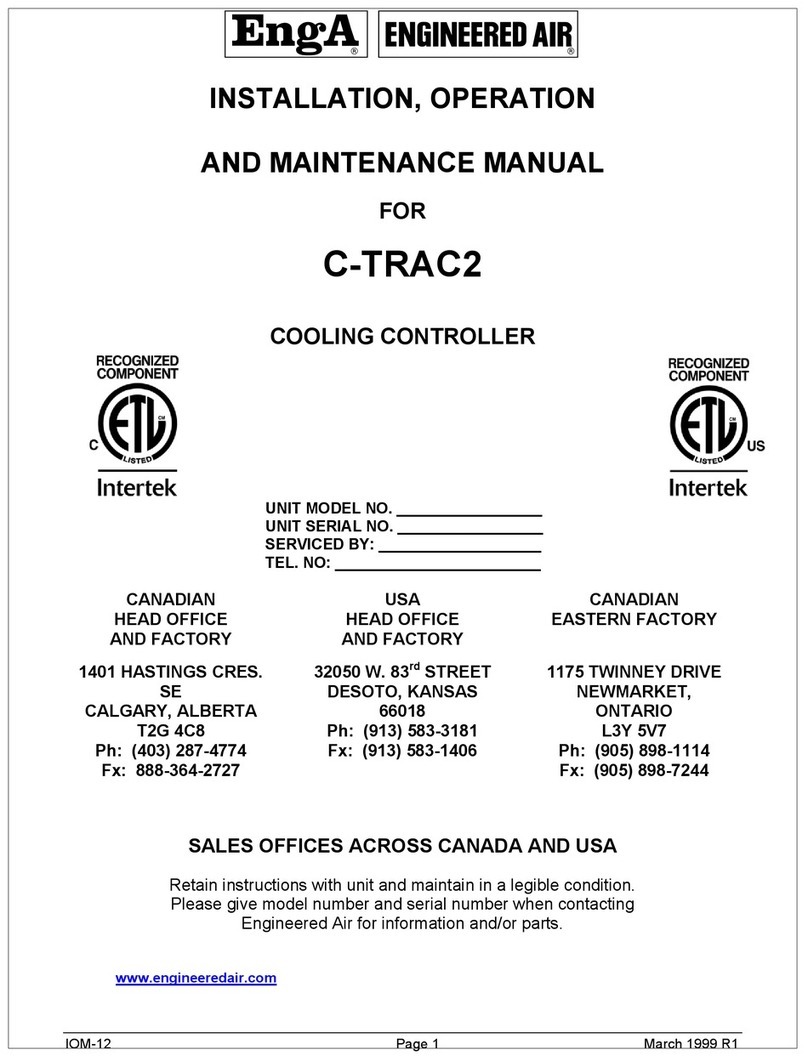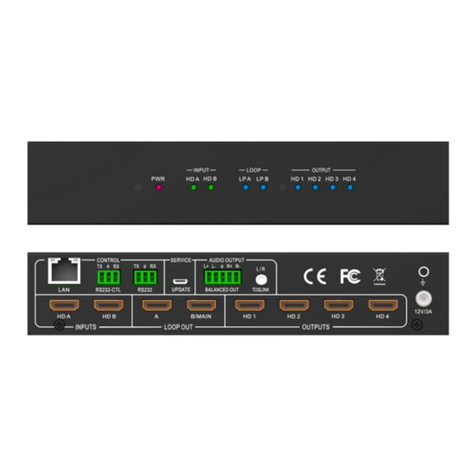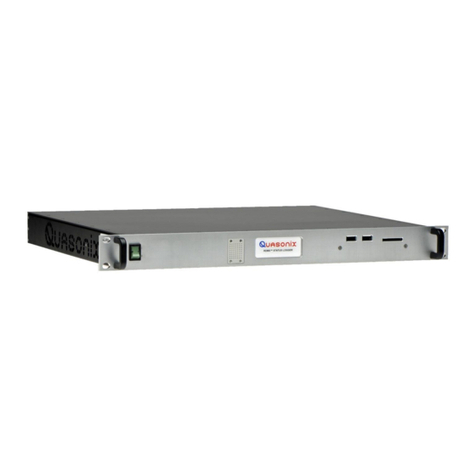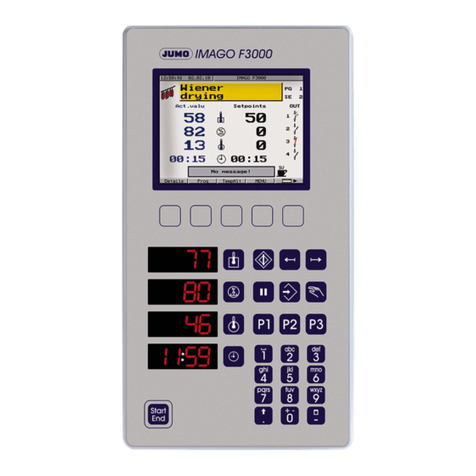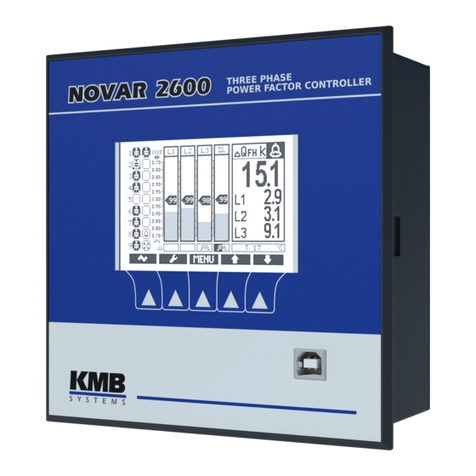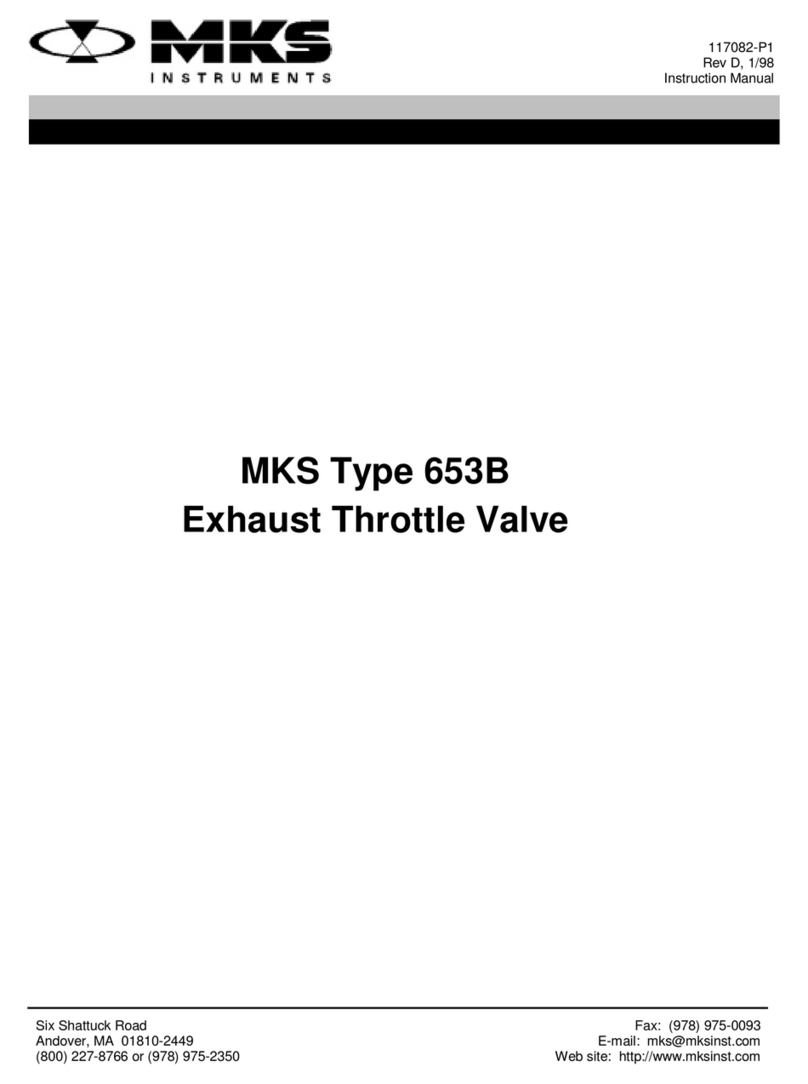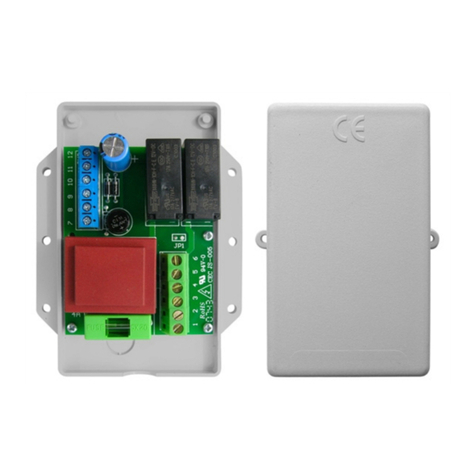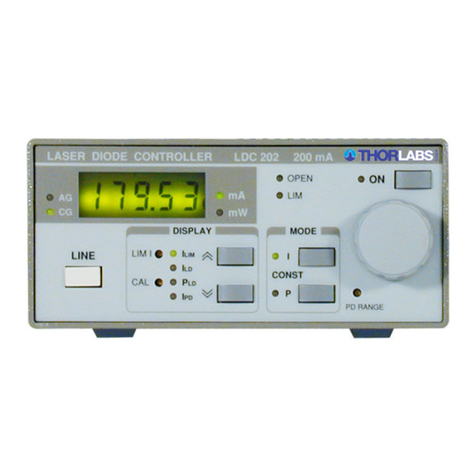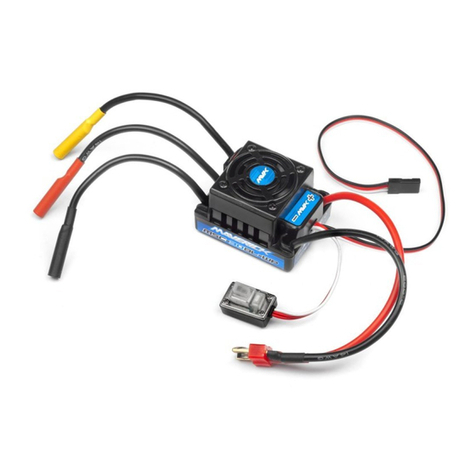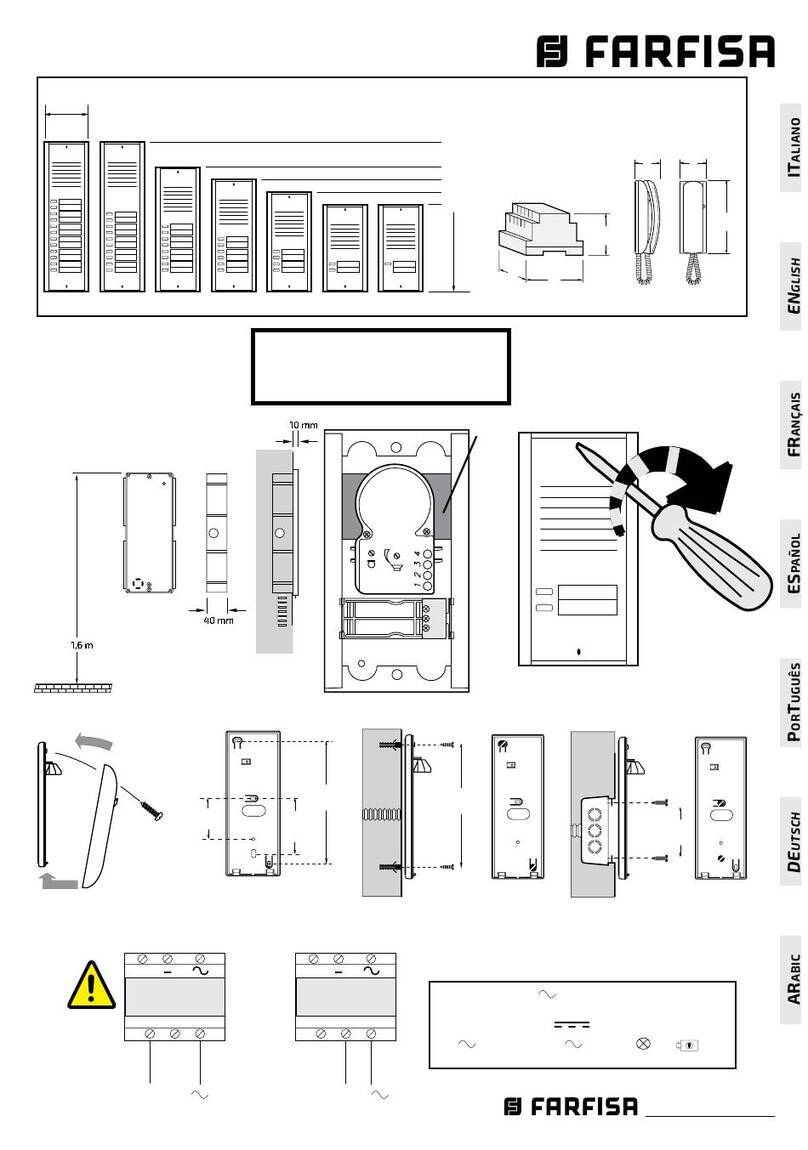TRIATEK HMS-1650 User manual

HMS-1650
Installation Manual
Version: 03.06.17
Triatek HMS-1650
Fume Hood Controller

Due to continuous improvement, Triatek reserves the right to change product specifications without notice.
CONTROLLER SETTINGS
HMS-1650 Fume Hood Controller Settings
HMS-1650
- 2 -
Fume Hood Name / Number
Unit Model Number and Serial Number (ESN)
This form should be completed during the initial configuration for each fume hood controller. See HMS-1650 Installation Manual
for details.
Network Setting
Address
Device ID Offset
Baud Rate
Setpoints
Sensor Input Range (zero-based or offset)
Occupied Mode Setpoint
Unoccupied Mode Setpoint
Standby Mode Setpoint
Analog Output
Operating Mode (Direct or PID)
Analog Output Range (zero-based or offset)
Analog Output Upper Limit (0 – 100%)
Analog Output Lower Limit (0 – 100%)
Analog Output Input Channel (AI-1 thru AI-4, TI-1 or TI-2)
Analog Output Action (Direct or Reverse)
Analog Output Range (zero-based or offset)
Flow Range (Maximum)
Flow Range (Minimum)
Sash Switch
Operating Mode (normally-open or normally-closed)
Delay Setting (0 - 240 secs)
Relay Output
Trigger Mode (Setpoints, Operating Mode or Timer-based)
Triatek reserves the right to change product specifications without notice. Triatek reserves the right to change product specifications without notice.

Due to continuous improvement, Triatek reserves the right to change product specifications without notice.
CONTROLLER SETTINGS
HMS-1650 Fume Hood Controller Settings
HMS-1650
- 3-
Input Channel (AI-1 thru AI-4, TI-1 or TI-2)
Occupied Mode High Setpoint (if Setpoints Mode)
Occupied Mode Low Setpoint (if Setpoints Mode)
Unoccupied Mode High Setpoint (if Setpoints Mode)
Unoccupied Mode Low Setpoint (if Setpoints Mode)
Relay Acting Mode (Direct or Reverse)
Delay Setting (0 - 180 secs)
PID Constants
Proportional Constant (0.5 – 100.0 %)
Integral Constant (0.0 – 100.0 %)
Derivative Constant (0.0 – 100.0 %)
Alarm Limits
Occupied Mode High Alarm Setpoint
Occupied Mode High Warning Setpoint
Occupied Mode Low Warning Setpoint
Occupied Mode Low Alarm Setpoint
Unoccupied Mode High Alarm Setpoint
Unoccupied Mode High Warning Setpoint
Unoccupied Mode Low Warning Setpoint
Unoccupied Mode Low Alarm Setpoint
Audible Alert
Enabled Input Channels (AI-1 thru AI-4, TI-1, TI-2)
Operating Mode (audible or silent)
Delay Time Base (secs or mins)
Delay Setting (0 – 60)
Alarm Quiet Period Starting Hour (0 – 23)
Alarm Quiet Period Ending Hour (0 – 23)
Engineering Units
Feet per Minute or Meters per Second
Triatek reserves the right to change product specifications without notice. Triatek reserves the right to change product specifications without notice.

Due to continuous improvement, Triatek reserves the right to change product specifications without notice. Due to continuous improvement, Triatek reserves the right to change product specifications without notice.
HMS-1650
- 4 -
FAST ACTING
ELECTRONIC ACTUATOR
Controller Actuator
120/24VAC, 30Va Transformer
Supplied by Triatek
120/24VAC, 20Va Third Party
Transformer
CORRECT
CORRECT
Triatek reserves the right to change product specifications without notice. Triatek reserves the right to change product specifications without notice.
Warning
Failure to follow the wiring diagrams could result in damage to your equipment and could
void your warranty. Wiring diagrams can also be found at www.triatek.com.
Under no circumstances should a single transformer be split between actuator and controller. Doing so
will damage the actuator, the transformer, the controller or all units. A single 120/24V 30Va transformer is
required for the controller and a separate 120/24V 20Va transformer is required for the actuator.

Due to continuous improvement, Triatek reserves the right to change product specifications without notice.
SUBHEAD
Table of Contents
HMS-1650
Due to continuous improvement, Triatek reserves the right to change product specifications without notice.
- 5-
TABLE OF CONTENTS
Triatek reserves the right to change product specifications without notice. Triatek reserves the right to change product specifications without notice.
SPECIFICATIONS
………………………………………………………………………………………….........………………………………… 6 - 7
GENERAL …………………………………………………………………………………………………………………………………….......… 8 - 10
Overview……………………………………………………………………………………………………………………...........……………8-9
Installation
………………………………………………………………………………………………………………………………… 10
MOUNTING/WIRING ………………………………………………………………………………………………………………........………11 -24
Case Dimensions ………………………………………………………………………………………………………………………… 11
Display Mounting Hole Pattern …………………………………………………………………………………………………………… 12
Controller Mounting Hole Pattern ………………………………………………………………………………………………………… 13
Sidewall Sensor Types …………………………………………………………………………………………………………………… 15
Sensor Mounting Hold Pattern/Placement ……………………………………………………………………………………………… 16
Sensirion Digital Sidewall Sensor (9-pin) ……………………………………………………………………………………………… 17
Honeywell Analog Sidewall Sensor (3 terminal)
……………………………………………………………………………………… 18
Analog Output to Pneumatic Actuator ………………………………………………………………………………………………… 20
Analog Output to Electric Actuator ……………………………………………………………………………………………………… 21
Analog Input Single Flow Sensor ………………………………………………………………………………………………………… 22
Analog Input Dual Flow Sensors ………………………………………………………………………………………………………… 23
Analog Input Sash Position Sensor ……………………………………………………………………………………………………… 24
Digital Input Occupancy Sensor ………………………………………………………………………………………………………… 25
Power ……………………………………………………………………………………………………………………………………… 26
Isolated Power Supply …………………………………………………………………………………………………………………… 27
COMMUNICATIONS
BACnet MS/TP …………………………………………………………………………………………………………………………… 28
Metasys N2 Open ………………………………………………………………………………………………………………………… 29
BASIC PROGRAMMING ……………………………………………………………………………………………………….......………… 31 - 33
Introduction
………………………………………………………………………………………………………………………………… 31
MainDisplayScreen …………………………………………………………………………………………………...........………………31-32
Configuring Fume Hood Monitor ………………………………………………………………………………………..………………… 32
Configuring Analog Output for Exhaust Damper Control ……………………………………………………………………………… 32
Calibrating Face Velocity Sensor ………………………………………………………………………………………………………… 32
Configuring Face Velocity Setpoints …………………………………………………………………………………………………… 32
Configuring Sash Position Sensor ………………………………………………………………………………………………… 32 - 33
Calibrating Sash Position Sensor ……………………………………………………………………………………………………… 33
Configuring Sash Height Settings ……………………………………………………………………………………………………… 33
Calibrating the Sash Control Feature …………………………………………………………………………………………………… 33
Configuring Face Velocity Alarm Setpoints ……………………………………………………………………………………………… 33
ChangingFumeHoodOperatingMode ……………………………………………………………………………...........………………33- 34
Changing Network Settings ……………………………………………………………………………………………………………… 34
Adding Password Security ……………………………………………………………………………………………………………… 34
Changing Display Settings ……………………………………………………………………………………………………………… 34
Built in Diagnostics ………………………………………………………………………………………………………………………… 34
MODULE SETTINGS
…………………………………………………………………………………………………………........…………… 35 - 41
CLEANING THE HMS-1650 DISPLAY …………………………………………………………………………………………………… 42
FLOW DIAGRAMS …………………………………………………………………………………………………….........…………………… 44 - 47
Unit Setup Tree …………………………………………………………………………………………………………………………… 44
System Setup Tree ………………………………………………………………………………………………………………………… 45
Display Setup Tree ………………………………………………………………………………………………………………………… 46
Diagnostics Menu Tree …………………………………………………………………………………………………………………… 47

Due to continuous improvement, Triatek reserves the right to change product specifications without notice.
- 6 -
HMS-1650
Due to continuous improvement, Triatek reserves the right to change product specifications without notice.
Electrical
4 Analog Inputs …………………………………………………………………………………………………………… 4-20mAdc, 0-5Vdc or 0-10Vdc
4 Analog Outputs ……………………………………………………………………………………………………… 4-20mAdc, 0-5Vdc or 0-10Vdc
2 Thermistor Inputs …………………………………………………………………………………………………… NTC Type 2 or 3, 10kΩ @ 25˚C
4 Digital Inputs ………………………………………………………………………………………… 0-5Vdc or 0-24Vdc, Active-High or Active Low
4 Relay Outputs ………………………………………………………………………………………………………………………………… 1A@24VDC
Control Signal Wire Size ……………………………………………………………………………………………………………… 18 AWG minimum
Power Supply ……………… Class 2, 24Vac ±10%, 30VA universal 120/240 to 24 Vac, 60/50 Hz, step-down isolation transformer provided
Communications
BACnet® MS/TP network …………………………………………………………………………………… Two-wire Twisted Pair, RS-485 signaling
Metasys® N2 network ………………………………………………………………………………………… Two-wire Twisted Pair, RS-485 signaling
Recommended Cable Type
………………………………………………………………………………………………………………… Belden 1325A
Touchscreen User Interface
LCD Size ……………………………………………………………………………………………………………………………………… 3.2” diagonal
LCD Type …………………………………………………………………………………………………………………………………… Transmissive
Resolution ……………………………………………………………………………………………………………………………… 240 x 320 portrait
Viewing Area ……………………………………………………………………………………………………………………… 50.60 mm x 66.80 mm
Color Depth ………………………………………………………………………………………………………………………… 18-bit or 262K colors
Backlight Color ………………………………………………………………………………………………………………………………………… White
Luminous Intensity ……………………………………………………………………………………………………………………… min 2500 cd/m2
GENERAL
Specications
Triatek reserves the right to change product specifications without notice. Triatek reserves the right to change product specifications without notice.

Due to continuous improvement, Triatek reserves the right to change product specifications without notice.
Mechanical
HMS-1650 Display Housing …………………………………………………………………………………………………………… 3”W x 5”H x .75”D
HMS-1650 Controller Housing …………………………………………………………………………………………………… 4.1”W x 6”H x 1.85”D
Environmental
Operating Temperature ………………………………………………………………………………………………………… 32° to 125° F Operating
Operating Humidity …………………………………………………………………………………………………… 10% - 95% RH, Non-condensing
HMS Air Flow Sensor
Type of Sensor ……………………………………………………………………………………………………………… Thru-the-hood ultra sensitive
Face Velocity Accuracy …………………………………………………………………………………………………………… 0-200 FPM ± 2 FPM*
Dimensions…………………………………………………………………………………………………………………… 25/32”H x 43/4”W x 35/16”D
NIST Traceable / Individual certification available as option
*@72°F ± 5°F
Venturi Valve (Order Separately)
Diameter…………………………………………………………………………………………………………………………… 6”, 8”, 10”, 12”, 14” & 16”O.D.
CFM Range ……………………………………………………………………………………………………………………………………………… 30-2400
Materials ………………………………………………………………………………………………………… Aluminum, Stainless Steel, Heresite Coating
Sound Insulation ………………………………………………………………………………………………………………………………………… Optional
Actuation ………………………………………………………………………………………………………………………………… Electronic or Pneumatic
Part Number Guide
Due to continuous improvement, Triatek reserves the right to change product specifications without notice.Triatek reserves the right to change product specifications without notice.
- 7-
HMS-1650
Triatek reserves the right to change product specifications without notice.
GENERAL
Specications
*Accuracy is ± 5FPM when velocity drops below 60FPM or exceeds 140 FPM
HMS1650 -1-1
Sensor Type Sash Sensor
1 = single smart sidewall sensor blank = sash sensor not included
2 = dual smart sidewall sensor S = sash position sensor included
A = single Honeywell sidewall sensor
B = dual Honeywell sidewall sensor

Due to continuous improvement, Triatek reserves the right to change product specifications without notice.
The Triatek HMS-1650 Series Fume Hood Controller is an ultra-sensitive
instrument used to monitor and/or control the fume hood face velocity in
laboratories and clean rooms. This unit is a precision measuring system
capable of measuring and displaying face velocities from zero to 200 ft/
min (1.016 m/sec) with an accuracy of ±2 ft/min.
Key features of the HMS-1650 include:
• Comprehensive closed-loop sash control with sidewall velocity
sensing
• Full-color touchscreen display with programmable display options and
adjustable backlight
• Intuitive user interface simplifies setup and configuration of unit
• Display background changes color to indicate hood status at a glance
• Audible and visual alarm annunciation
• Auxiliary universal analog inputs for use with optional sensors
• Four independent PID control loops for controlling damper actuators,
speed drives, hot water valves, humidifiers, etc.
• Digital input used to monitor an optional fume hood sash switch, zone
presence sensor, or emergency override switch
• Relay outputs used for transmitting alarm condition to remote location
• Dedicated thermistor inputs for temperature monitoring and/or control
applications
• Multi-level password protection of touchscreen user interface
• Field Calibration of both sidewall velocity sensor and optional sash
position sensor
• Multi-protocol native (BACnet®, Metasys® N2) for easy integration
with any BMS
• Manual override of Analog and Relay outputs assist with Test &
Balance procedures
• Comprehensive Real-Time View diagnostics tool displays built-in to
each unit
• Easy-to-install backplane/backplate assembly facilitates permanent
termination of all wiring
The HMS-1650 is equipped with a 3.2” diagonal Full-color
Touchscreen display in portrait orientation (240 x 320). The password-
protected menu tree is very intuitive and simplifies the setup and
configuration of the unit. The menus incorporate touch-based interfaces
such as sliders, radio buttons, and dialog popups to facilitate the ease-
of-use of the HMS-1650.
The display implements bright background color changes to indicate the
three different Alarm Status indications of the monitored fume hood.
These background colors indicate “Normal” when the face velocity is
within defined limits, “Warning” when the face velocity is nearing an out-
of-limits condition, and “Alarm” when the face velocity is outside defined
acceptable limits. The face velocity ranges for these conditions are
easily set by the user for the specific installation when necessary. The
background color changes provide an overview of the monitored fume
hood face velocity conditions at a glance.
Alarm conditions may be defined by the user, in terms of desired face
velocity settings for the fume hood being monitored. When an alarm
condition occurs, it may be annunciated in four user-definable ways: 1)
on the display, 2) with an audible alarm, and 3) transmitted via contacts
to a remote monitoring location and 4) over the BMS network. The alarm
will automatically reset when the unit has sensed that the fume hood
face velocity has returned to proper limits. The operator may easily mute
the audible alarm by touching the OK button on the alarm notification
message popup window of the touchscreen display.
For many applications, it is important to have other variables such as
sash position or ambient temperature displayed along with the fume
hood face velocity. The HMS-1650 provides for this by means of three
additional Universal Analog Inputs, each of which may be configured
for either current loop operation or voltage input operation (0-5V, 1-5V,
0-10V, 2-10V, 0-20mA, 4-20mA). Each input may be scaled as needed
to display correct values, and may have an engineering units selection
associated. The configuration of each analog input is field selectable
through the use of miniature dipswitches on the controller unit.
For those applications requiring monitoring and/or control based
on temperature variances, the HMS-1650 provide two dedicated
Thermistor Inputs in addition to the four universal analog inputs.
Therefore, a total of six analog inputs are available for control
applications. The two thermistor inputs may be used with negative
temperature coefficient (NTC) Type 2 or Type 3 sensors.
The HMS-1650 provides four Universal Analog Outputs, which may
be configured for either current loop operation or for voltage operation.
Each analog output may be configured for proportional operation to
provide a linear signal to the BMS, or for PID (proportional-integral-
derivative) control operation for closed-loop feedback control of
damper actuators, variable frequency (speed) drives, hot water valves,
humidifiers, or other analog-controlled devices. Each universal analog
output may be field-configured for the required application using onboard
configuration dipswitches on the controller module. Each analog output
GENERAL
Overview
HMS-1650
Triatek reserves the right to change product specifications without notice.
- 8-
Triatek reserves the right to change product specifications without notice.

Due to continuous improvement, Triatek reserves the right to change product specifications without notice.
may also be temporarily overridden using the built-in diagnostic tools for
troubleshooting during the installation and commissioning phase.
The HMS-1650 provides four Digital Inputs that may be used for
monitoring sash switches, override switches, flow switches, occupancy
sensors or other devices with binary outputs. The configuration and
operation of each input may be configured by the user to define
the effect of a change in its state. Each digital input may have a
programmable delay duration associated with it. Each digital input may
be configured for either normally-closed or normally-open operation, and
may also be configured to be active-high or active-low triggered. The
global configuration of the digital inputs is field selectable through the
use of a configuration switch on the controller unit.
The HMS-1650 provides four Relay Outputs, which may be configured
for either direct-acting or reverse-acting operation, and may have a
programmable delay associated to meet the specific needs of the
required application. A unique feature of the HMS-1650 is its ability to
trigger a relay output for the purpose of activating an optional automatic
sash closer device, thereby keeping an unattended fume hood with
an open sash safe for occupants of the lab. Each relay output may
also be temporarily overridden using the built-in diagnostic tools for
troubleshooting during the installation and commissioning phase.
The user may set up multiple multi-level Passwords to prevent
unauthorized or casual access to the HMS-1650 configuration settings.
Up to ten passwords of up to eight digits may be programmed, with
each having one of four associated access levels. Administrators and
Facility Management personnel may have unrestricted access, while
general staff may be assigned restricted access passwords which limit
the functionality of the user menus.
Fume hood operating mode selection of Occupied, Unoccupied, or
Standby may be protected using limited access passwords, thereby
eliminating the need for keylock switches and keys. However, an
Optional Keylock Switch may be used to further control access to
change in operating modes.
The HMS-1650 provides a unique set of built-in diagnostics tools that
are extremely valuable for facilitating the troubleshooting process during
the installation and commissioning phase. Included in these built-in
diagnostics tools are Manual Override capabilities for both analog
outputs and relay outputs, and a comprehensive Real-Time View
capability that allows the real-time values and states of each analog
and digital input and output to be displayed conveniently. This is an
extremely useful tool that facilitates the verification and certification
processes conducted by typical test and balance personnel during
the commissioning of the system. There are also options for storing
configuration settings and for restoring those settings, as well as
performing a complete restoration of the factory default configuration
settings.
The HMS-1650 touch-screen user interface incorporates an easy-to-use
Manual Override capability that allows the unit’s analog and digital
outputs to be overridden independent of their proportional or PID loop
control operation. This is an extremely useful function that facilitates the
verification and certification processes conducted by typical Test and
Balance personnel during the commissioning of the system.
The HMS-1650 incorporates an innovative Backplane/Backplate
assembly which greatly facilitates the installation process and permits all
wiring terminations to be permanent. The HMS-1650 serves as a direct
drop-in functional replacement for all previous models of HMS-1600
series of BACnet/N2 fume hood controllers.
Depending upon the actual model number ordered, the HMS-1650
may be accompanied by one of two types of sidewall sensor
modules for measuring face velocity. The standard sidewall sensor
includes a 9-pin pluggable terminal block connector, while the
Honeywell sidewall sensor includes a 3-position terminal strip.
See pages 13 through 14 for physical representations of the two
sidewall sensor options.
SUBHEAD
Overview
HMS-1650
Due to continuous improvement, Triatek reserves the right to change product specifications without notice.
- 9 -
Triatek reserves the right to change product specifications without notice.
GENERAL
Triatek reserves the right to change product specifications without notice.

Due to continuous improvement, Triatek reserves the right to change product specifications without notice.
This section will illustrate a typical method of installing the HMS-1650
to a fume hood. Tools required include: drill, 3/8 drill bit, 1/8 drill bit,
Phillips #2 screwdriver, standard medium blade screwdriver, silicone
sealant.
Depending upon the actual model number ordered, the HMS-1650
may be accompanied by one of two types of sidewall sensor
modules for measuring face velocity. See pages 15 through 18 for
physical representations of the two sidewall sensor options.
1. Proper location of the sensor is very important for obtaining
the best possible operation of the HMS-1650. The system
uses through-the-wall sensing to measure the internal negative
pressure of the fume hood to accurately determine the face
velocity. The sensor must be located in a position that is least
affected by turbulent air within the hood. See illustration on page
16. There are two types of fume hood arrangements which need
to be considered: By-Pass and Non-By-Pass.
• Front-to-Back Position – With either type of fume hood
arrangement, the sensor is best located approximately 6
inches back from the vertical sash track.
• Vertical Position (By-Pass type) – Locate the sensor
vertically in the center of the region between the bottom of
the sash in the fully open position and the bottom edge of the
by-pass opening.
• Vertical Position (Non-By-Pass type) – Locate the sensor
vertically 6” above the bottom of the sash in the fully open
position.
2. See page 16 for dimensions and suggested mounting
arrangements of the Triatek flow sensor on the hood wall. NOTE:
Be certain that sensor reference port is in laboratory room
air. If necessary to obtain this, use Triatek HMS-1600-PLATE
mounted on exterior panel of the fume hood.
3. Apply silicone sealant around the sensor immediately prior to
mounting the assembly to its mounting surface. Be careful to
avoid getting sealant in the sensor port.
4. See page 12 for mounting details for the HMS-1650 display unit.
The preferred location is eye level, usually on one of the side
bezel panels. Please note that the display unit is cable connected
to the control unit, and provision must be made to route the cable
without interference with the fume hood sash or sash cable. The
control unit is typically secured in a convenient location on top of
the fume hood. (See page 13)
5. For standard sidewall sensors, at the HMS-1650 backplane,
assuming the colors of the 3-conductor signal cable being red,
black, and white, connect the leads to the terminals as follows:
Red: SNS_PWR
Black: AGND
White: AI_1
If a Honeywell sidewall sensor is being used, the signal cable
leads should be connected to the HMS-1650 backplane terminals
as follows:
Red: +10V
Black: AGND
White: AI_1
For standard sidewall sensor modules with the 9-pin terminal
block, connect the 3-conductor signal cable as follows:
Red: +Vin
Black: GND
White: Vo
For Honeywell sidewall sensor modules with the 3-position
terminal block, connect the 3-conductor signal cable as follows:
Red: +
Black: G
White: IN
6. Power supply connections - input voltage must be Class 2, 24
VAC or 24 VDC. A step-down isolation transformer is supplied
with the HMS-1650. Triatek recommends that the HMS unit be
powered using the supplied transformer, and that only one unit be
powered with each transformer. Do not power any other device
with the same transformer. See pages 26 and 27 for connection
details.
7. All wiring should conform to the Local Regulations and the
National Electrical Code. Take precautions to prevent routing the
sidewall sensor wiring in the same conduit as line voltage or other
conductors that supply highly inductive loads such as generators,
motors, solenoids or contacts, etc. For all wiring connections, use
22 AWG or larger.
8. After the installation is complete, apply power to the unit, open
the sash to a normal operating position and observe the flow
reading on the touchscreen display. If necessary, proceed to the
Programming Section beginning on page 31.
MOUNTING/WIRING
Installation
HMS-1650
- 10 -
Triatek reserves the right to change product specifications without notice. Triatek reserves the right to change product specifications without notice.

Due to continuous improvement, Triatek reserves the right to change product specifications without notice.Triatek reserves the right to change product specifications without notice.
MOUNTING/WIRING
HMS-1650
- 11 -
Right Side
View
Left Angle
Side View
HMS Case Dimensions
Triatek reserves the right to change product specifications without notice.
Recommended Cable Type:
Belden 1325A
Control Unit

Due to continuous improvement, Triatek reserves the right to change product specifications without notice.
MOUNTING/WIRING
Display Mounting Hole Pattern
HMS-1650
Triatek reserves the right to change product specifications without notice.
- 12 -
Triatek reserves the right to change product specifications without notice.
The HMS-1650 display backplate may be mounted directly to a standard single-gang wall
box using the two slots along the centerline. Use the backplate as a template to mark the
mounting holes and the cable access hole at the center of the backplate.

Due to continuous improvement, Triatek reserves the right to change product specifications without notice.Triatek reserves the right to change product specifications without notice.
MOUNTING/WIRING
Controller Mounting Hole Pattern
HMS-1650
Triatek reserves the right to change product specifications without notice.
- 13 -

Due to continuous improvement, Triatek reserves the right to change product specifications without notice.
MOUNTING/WIRING
HMS-1650
Triatek reserves the right to change product specifications without notice.
- 14 -
Triatek reserves the right to change product specifications without notice.
Failure to properly identify the sensor that came with your HMS
controller could result in incorrect wiring and sensor damage.
Make sure you use the correct wiring sequence for the sensor
you received.
For reference, photos of both types of sensors are provided on
the following page. If unsure as to which type of sensor you have
and/or how to properly wire the sensor you received, contact the
factory at 888-242-1922.
Warning

Due to continuous improvement, Triatek reserves the right to change product specifications without notice.Triatek reserves the right to change product specifications without notice.
MOUNTING/WIRING
Sidewall Sensor Types
HMS-1650
Triatek reserves the right to change product specifications without notice.
- 15 -
SENSIRION Digital Sensor
(Standard 9-Pin)
Wire According To Illustration Found
on Page 17.
HONEYWELL Analog Sensor
(3-Terminal)
Wire According To Illustration Found
on Page 18.

Due to continuous improvement, Triatek reserves the right to change product specifications without notice.
MOUNTING/WIRING
Sensor Mounting Hole Pattern
HMS-1650
Triatek reserves the right to change product specifications without notice.
- 16 -
Triatek reserves the right to change product specifications without notice.
2
3
/16”
43/
8
”
1/8DIA (typ 4 places)
3/8DIA
Sensor Placement - Non By-Pass Type
11/2”
6.00"
6.00"
Ø 0.50"
The P1 Port must be
referenced to the Laboratory
air for proper operation
and should be a located away
from air turbulence.
Bottom edge
of sash in
uppermost
position
Sensor
If the hood is bypassed
or in close proximity to items
like baffles, deflectors, etc.,
contact the factory.

Due to continuous improvement, Triatek reserves the right to change product specifications without notice.Triatek reserves the right to change product specifications without notice.
MOUNTING/WIRING
SENSIRION Digital Sidewall Sensor (9-pin)
HMS-1650
Triatek reserves the right to change product specifications without notice.
- 17 -
Bottom edge
of sash in
uppermost
position
NC
NC
GND
NC
NC
NC
Vo
GND
+Vin
NC
NC
GND
NC
NC
NC
Vo
GND
+Vin
FIGURE 2
Alternate Sensor
Mounting
Interior of
Fume Hood Flexible Tubing (3 ft.
Supplied)
To HMS 1650
This port must be referenced
to laboratory air for proper
orientation and should be located
away from turbulence.
Exterior of
Fume Hood
FIGURE 1
Preferred Sensor
Mounting
Interior of
Fume Hood Flexible Tubing (3 ft.
Supplied)
This port must be referenced
to laboratory air for proper
orientation and should be located
away from turbulence.
Exterior of
Fume Hood
To HMS 1650

Due to continuous improvement, Triatek reserves the right to change product specifications without notice.
MOUNTING/WIRING
HONEYWELL Analog Sidewall Sensor (3-terminal)
HMS-1650
- 18 -
Triatek reserves the right to change product specifications without notice. Triatek reserves the right to change product specifications without notice.
OPTIONAL
IN
+
G
IN
+
G
Interior of
Fume Hood
To HMS
Control Unit
To HMS
Control Unit
Interior of
Fume Hood Exterior of
Fume Hood
Exterior of
Fume Hood
Flexible Tubing
(3 FT Supplied)
This port must be
referenced to Laboratory
air for proper operation,
and should be located
away from air turbulence.
Flexible Tubing
This port must
be referenced to
Laboratory air for
proper operation,
and should be
located away from
air turbulence
Attach louvered plate
assembly here.
FIGURE 2
Alternate Sensor
Mounting
FIGURE 1
Preferred Sensor
Mounting

Due to continuous improvement, Triatek reserves the right to change product specifications without notice.
MOUNTING/WIRING
Notes
HMS-1650
- 19 -
Triatek reserves the right to change product specifications without notice. Triatek reserves the right to change product specifications without notice.

Due to continuous improvement, Triatek reserves the right to change product specifications without notice.
MOUNTING/WIRING
Analog Output to Pneumatic Actuator
HMS-1650
Triatek reserves the right to change product specifications without notice.
- 20 -
Triatek reserves the right to change product specifications without notice.
NOTE: If using Honeywell sidewall sensor module, the
three terminals are +, IN, and G. The + terminal should be
connected to +10V; IN should be connected to AI_1, and G
should be connected to AGND at the HMS-1650 backplane.
Controller Configuration Dipswitch Settings
S1 - 1 = OFF, S1 - 5 = OFF (AI - 1 set as 0-5V Input)
Table of contents
Other TRIATEK Controllers manuals

